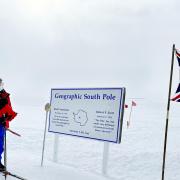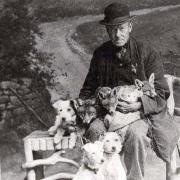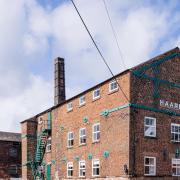Popular local author Roz Watkins talks about her third published crime novel, set in Derbyshire

A Derbyshire crime writer is celebrating the eagerly awaited publication of her latest book. Cut to the Bone, by Roz Watkins, is the third novel in her DI Meg Dalton series, which features locations from around the county.
Published by Harper Collins, Cut to the Bone begins with the disappearance of an 18-year-old woman from an abattoir in a fictional Peak District village.
‘The victim is a blogger who has become a famous celebrity for barbecuing meat products in a bikini’ explains Roz. ‘When traces of her blood and hair are found in a trough at the abattoir where she worked, DI Meg Dalton has to work out whether the young woman is dead or missing. There is lots of conflict and Meg, who’s a vegetarian, gets accused of siding with animal rights activists.’
For each of her books, Roz devotes a considerable amount of time to research. This close attention to detail comes as no surprise as Roz was previously a partner at a patent law firm in Derby. As well as researching the workings of abattoirs for this novel, she spent a day with Derbyshire Police to learn about procedures for missing persons. She visited the control room where calls come in, met officers who operate the drones to assist in missing persons cases, as well as firearms operatives.

‘I also chatted to detectives about their daily lives,’ says Roz. ‘A lot of a murder or missing person investigation is quite mundane such as spending a day checking through number plate or phone data. People don’t want to read this in a novel but it’s good to have some authenticity.’
The locations in Roz’s novels form an integral part of the story and are as important to the plot as the characters. To this end, she will work out where the stories are set very early on.
‘The whole feel of an area is really important to me,’ says Roz. ‘In The Devil’s Dice, Wirksworth, together with Shining Cliff Woods in Ambergate, are used as the inspiration for the fictional town of Eldercliffe whilst the Nine Ladies stone circle on Stanton Moor, near Matlock, also features.’ In Dead Man’s Daughter, Meg’s case takes her to Bonsall and then to Flash, the highest village in Britain, where the detective finds herself travelling to during a snowstorm.
In Cut to the Bone, Roz heads further north to Gritton, a fictional town inspired by the two former villages of Derwent and Ashopton, which were flooded to create the Ladybower Reservoir.

‘I visited Ladybower on a rainy winter’s day when the water was flooding down the huge plugholes,’ says Roz. ‘It was really eerie.’
Woven through the plot of Cut to the Bone is the myth of the pale child.
‘A kid lived in a big old house in one of the drowned villages. There is a rumour that when the house got flooded she turned bad and started looking for people to look after her,’ she explains. ‘But this meant they had to die. A few people had seen her face and died and the disappeared girl in my story had seen her too. Although it makes no sense this ghost is part of the mystery for Meg. But Meg finds herself at odds with others in the police force who think it can’t possibly be relevant.’
It is not only locations that Roz can find eerie but, through her choice of settings and plot lines, she reflects on her seemingly uncanny ability to predict the future.
READ MORE: Best-selling author Alison Weir on her Six Tudor Queens series and her Derbyshire connections ‘I started writing Cut to the Bone in 2017 when I wrote about a burning hot summer where the flooded villages under Ladybower became visible. I made it up in my story but then it happened the following year!’ Yet more uncanny was Roz’s choice of location for her fourth novel – the plague village of Eyam, which she is currently writing. Planned out before the pandemic, the location and plot line became rather too close to the truth for Roz who found writing about isolation and lockdown during the real-life current pandemic very difficult. ‘I’m lucky I have a job I can do at home but writing has been a bit weird and at first I found it hard to focus, given I was writing about the plague.’ says Roz. Covid-19 also meant the planned book launch at Waterstones in Derby in June was cancelled, as was a programme of talks and workshops, although Roz is now delivering some of these online. However, it’s not the same. ‘I don’t enjoy them in the same way as getting out and meeting people’ admits Roz. Roz’s page-turning plots also explore gritty themes including assisted dying and, in her latest novel, factory farming. She says, ‘I’ve been really angry with the awful way we treat factory farmed animals. These problems have become even more current and I think the next big pandemic will start in a factory farm as this is a breeding ground for viruses. ‘In a factory farm, viruses can easily jump from one animal to the next. The cost to our planet and the human race is vast. It’s all short-term thinking.’ Despite her strong feelings, Roz weaves such themes into her book in the hope of raising awareness rather than preaching. ‘I’m not saying it’s bad for people to eat meat but some reviewers have said it’s made them think about buying free range pork’ says Roz. When Roz isn’t writing she helps her partner run their small holiday cottage business in Alderwasley where they live, looks after what she describes as her ‘menagerie of animals’ - three horses, three cats and a dog (although she says, ‘they are not all ours – animals just seem to turn up here!’), as well as regularly walking in the Peak District where she is always scouting out potential locations and thinking up ideas for future books. For any would-be crime writers, Roz has top tips that she attributes to her own success. ‘Write about something you feel really strongly about and want people to know about,’ she suggests. ‘Read loads of crime novels and analyse what the writers are doing. I read a lot of ‘How To’ books – in particular screenwriting books, which are good for structure. Your story has to be compelling enough to write.’ To illustrate her point Roz likens books to houses. ‘I’ve lived in lots of houses but I don’t know how to build one. In the same way I’ve read lots of novels but didn’t know how to build a book so I had to learn! I also need feedback as I absolutely can’t judge my own work. Critiques are very helpful and if you get published you’ve got to get used to people feeding back on your books, whether it’s good or bad.’ One only has to pick up her books to see how the places and landscapes of Derbyshire inspire Roz’s writing and, should you meet her when out walking in the Peak District with her dog, she’s sure to be plotting her next novel! Cut to the Bone by Roz Watkins is available from bookshops priced £12.99.Never miss a beat. Follow Derbyshire Life on Facebook, Twitter and Instagram.



























